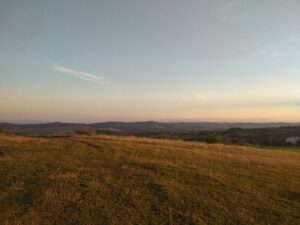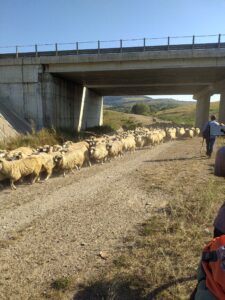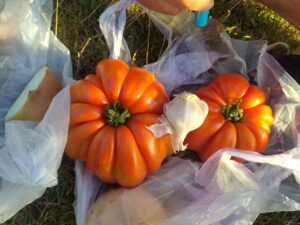I saw that the blog wasn’t updated for a while so wanted to share my experiences of three weeks on the biketour in Romania.
After a loooong train journey to reach Arad, I saw that the local trains from Arad all leave at either 5 in the morning, or 5 in the evening. Given that a journey of 150km was going to take 4.5 hours, which would then deposit me in the middle of nowhere in darkness, practicallity won and a got on a train at 5am heading for Brad. The train looked like it was 60 years old,had a colour scheme inside of ‘brown’ and collected all the overgrown hedges on the way through the windows. I also got charged 2 times my ticket price for the bike, which at the time seemed overpriced (until later in the tour, where we got charged 9 times the ‘person’ ticket fare for a bike, then in comparison it seemed reasonable). Departing the train, I cycled a few km in the direction of the tours last camp site and chilled under a tree to eat breakfast. 10 minutes later the first person passed me — someone I had met a few weeks ago at cyclocamp — my first friendly face! Shortly followed by another one — someone I had met on ecotopia 2022. And so began my first cycling day
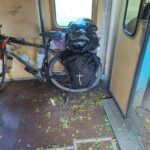
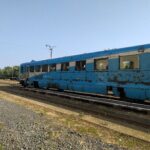
I had intercepted the biketour on the route between Timișoara and Cluj. The area belongs to the Carpathian Mountains . we climbed a road, then a gravel path, up the side of a hill and joined the others lounging on a field full of cropsicals (a newly invented term for the drying piles of hay with sticks in the middle, because they look like upside down popsicles (ice lollies))
Our camp site that night was quite high up and offered a wonderful view over the mountains
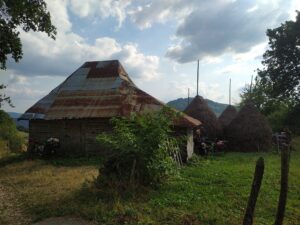
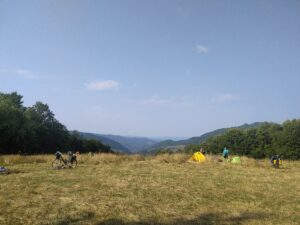
The next day we continued further, following a river in the valley but still with spectacular views.
We passed nearby to a village called Roșia Montană, coincidentally the same route as the biketour 2013. In 2013 the biketour passed by here to support struggles against the plan to open Europe’s largest goldmine here. At the time there were protests over the whole country against the planned mine. The project was delayed and stalled, and the sucess of the activists includes Roșia Montană being classified as a historic site of national importance, thus, industrial activity is prohibited in the area. In 2021, Roșia Montană became a part of the UNESCO World Heritage list and was also included in the List of World Heritage in Danger. Following these measures, any mining activity in Roșia Montană is prohibited in the future.
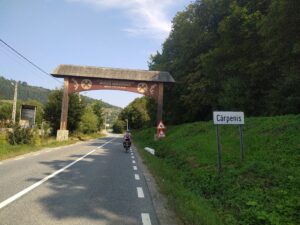
It was also a hard day though because the trailer finally gave in to poorly paved roads and a tyre split open- we were reaaaally far from any bikeshops. There was some stitching attempts and some hitchhiking back and forth to get a innertube, but in the end it was just too broken and had to be abandoned. Most of the group camped in a local field but a few people didn’t make it because of the trailer-fixing attempts. The campsite was reached by crossing an incredibly unstable looking bridge that magically didn’t break under the weight of 20 bikes, luggage and trailers.
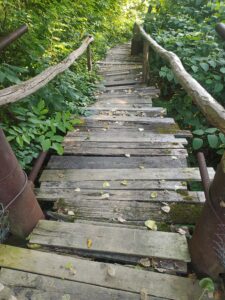
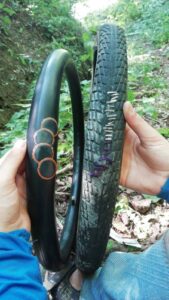
The next morning was a slow morning, as we waited for the broken-trailer group to catch up and some people hiked to the waterfall nearby (yes! Hiking! Sometimes it’s good to use other muscles!) We continued north, stopping only to eat Langos, a type of Hungarian fried bread product that also exists in parts of Romania, due to certain regions having been part of Hungary, then Romania, then Hungary again, and currently now Romania again.
Our campsite that night was next to a fishing lake near Iara, where we cooled down in the river. Sadly, the river edges were quite full of trash. It seems like the trash collection system in Romania isn’t always working so well in rural parts, it was quite common to see trash piling up near rivers or edges of forest.
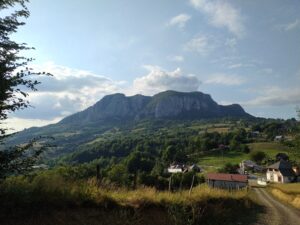
The next day under blazing sunshine we rolled into Cluj and met our hosts from Acasa — a self organised space for anti-capitalist and anti-authoritarian politics. We learned that the space is not so old, and they managed to find the space because it’s located in a Roma neighbourhood and therefore quite cheap. This is because of the high levels of discrimination and negative stereotypes associated with Roma people, meaning they are not viewed as desirable neighbours.
We ate dinner at a sister-project of ACasa — a cooperative bakery making vegan products. It was mega tasty and the space so welcoming. Bellies full of freshly made cabbage pies and home-brewed kombucha, we went back to Acasa to browse the extensive library , which had literature in 10 different languages and endless themes — something for everyone!
Sadly I forgot to take any photos in Cluj, probably because of a busy schedule of city-seeing, circles, epic meals, countless washing machine rounds, workshops and museum visits. Here also a few people were leaving and new ones joining.
We also held a presentation about the biketour and had an lively karaoke night in the living room with our hosts.
Some of us made a excersion to the Turda Salt Mines. The main road to cycle there was horrible, so we quickly left it and cycled on what appeared to be mountain bike-tracks, great fun if you are without luggage! No cars, just forest and sheep and landscapes.
The salt mines were huge, so huge, that they had build a theme-park with mini-golf and a Ferris wheel inside. Bizarre..
We learned that salt was mined from here for hundreds of years. An information-board told us that the salt was brought to the surface using machines powered by horses, but due to the lack of natural light the horses went blind and had to be replaced quite often.
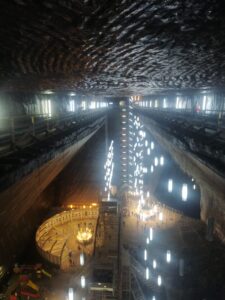
After Cluj we started our 2 day journey towards our next project. Once we were 20 km away from Cluj the way was sometimes gravel and quite rural. On the way we passed the village of Sic, and because it was so hot, had a Siesta in a park there. There seemed to be some kind of village festival happening. One man persuaded his teenage child to talk with us and she explained that the village is Hungarian, most of the people (94%) are ethnic Hungarians, because this region used to be part of Hungary. They are also still keeping some traditions alive — see this article here.
We camped this night next to a lake and enjoyed the sunset.
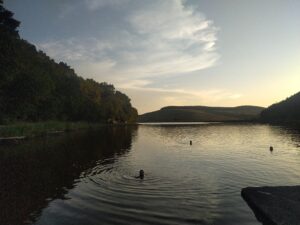
The next day the sun was HOT and the way GRAVEL — great combination! An uphill after breakfast and then just gravel roads connecting tiny villages. Away from the cities it was quite regular to encounter either street dogs or dogs from locals houses who were protecting their houses. I guess they are not so used to cyclists so we had many close encounters and were chased frequently by dogs. One person said however that the situation is much better than in the past, because now there are many more schemes funding the sterilisation of street dogs.
What makes the villages in Romania interesting is that every house is different. Different colour, different building style, different roofs…
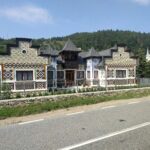
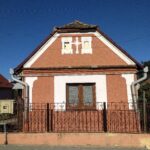
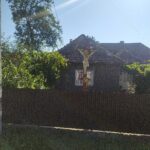
We arrived in the evening to our hosts Ermitaj Malin.
Ermitaj is an offgrid eco-project in Transylvania focusing on permaculture and agro-ecology. We arrived exactly one week before they would be hosting the first permaculture gathering in Romania, in Romanian. Our hosts there are Belgium, and explained to us the difficulties of moving to rural communties. They have learned Romanian and place a big focus on making connections to the local people and learning from them (lots of people in rural Romania grow a lot of their own produce, which you can see as you cycle through villages, because there are tables full of produce for sale everywhere. Also so much honey!) as well as bringing new ideas and concepts into the community. For example, they told us about how they organised a clean-up day to remove trash from the forest together with the village, to start conversations about why its harmful to dump trash in the nature. I found the place super inspiring to see how much progress they have made over the years, and also valued the honesty from the hosts when explaining all the challenges in setting-up such projects. A highlight was also reading their guest book and seeing an entry from another biketour participant from many years ago!
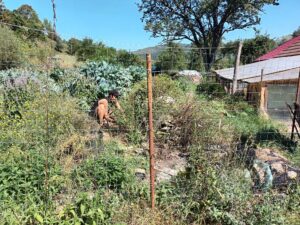
At the end of Ermitaj there was another round of goodbyes as a lot of people left. 8 of us set-off from Malin direction south for more adventures. On the first day we had the first wild-rain-storm of my time on the bike tour. Stuff was blowing everywhere. We took shelter in a church pavilion but then it got dark, we thought about sleeping there. Some local came and we thought maybe we would get sent away but he said we could stay. Then another one came and bought us home-grown tomatoes and home-made cheese — a very kind gesture! I missed some things about the big group but also really enjoyed getting to know everyone from our little group much better, and organising everyday things was much easier with 8 people. And I think with 20 people we wouldn’t have been able to sleep outside the church.
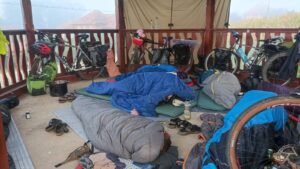
We continued cycling towards Sibiu the next day. Sometimes passing horse and carriages — not an unusual site! We camped this evening next to a river, which we later found out is used as cooling water for the nearby gas-power electricity station. One of us got stuck in mud on a bad-road and some people went on a midnight trek to rescue them, but everyone had dinner in the end
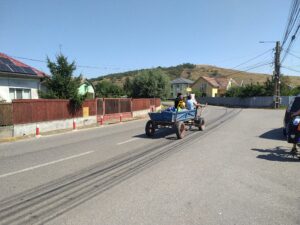
The next day after a lazy morning (the midnight mud-hiking was exhausting) by the river we continued. The roads were small but very busy — no gravel but 1000 cars, not all of which appreciated cyclists. We stopped to make camp on a hill-top, enjoying the sunset and the views of the higher Carpathian mountains in the distance
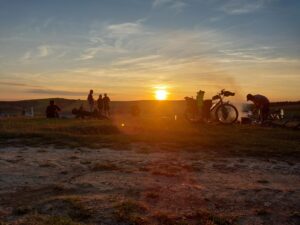
Next day — Sibiu! 65km to go in hot hot sunshine but we pushed through. Well some people cheated and got the train to avoid the busy roads, and then had to pay 9 times the person fare for the bike.. Ouch!!The rest of us made a break at a lake
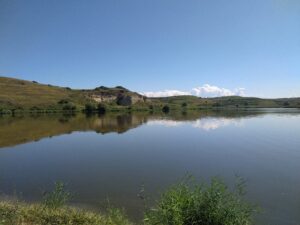 Our host was living near Sibiu and somehow had heard of ecotopia through the gatherings from many years before! He lives in a town called Ocna Sibiului — known for the former salt mines there that are now filled with water and used a therapeutic baths. Which also happened to be free to enter after 8pm. What better way to wash off our salt sweat than getting into a salt lake. There was also a mud bath to scrub off the layers off grime.
Our host was living near Sibiu and somehow had heard of ecotopia through the gatherings from many years before! He lives in a town called Ocna Sibiului — known for the former salt mines there that are now filled with water and used a therapeutic baths. Which also happened to be free to enter after 8pm. What better way to wash off our salt sweat than getting into a salt lake. There was also a mud bath to scrub off the layers off grime.
The next day we visited Sibiu. The town was pretty and is known for the ventilation windows on the roofs of the houses that look like eyes. However it was quite touristy and therefore expensive.
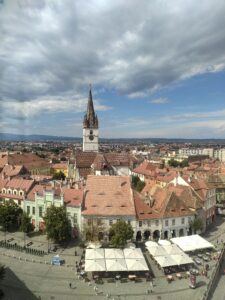
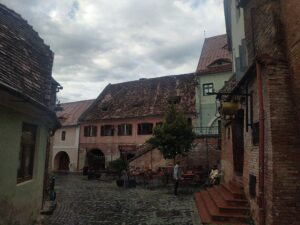
The day in Sibiu ended my time with the bike tour. The group left towards the next challenge — crossing the higher Carpathian mountains!






